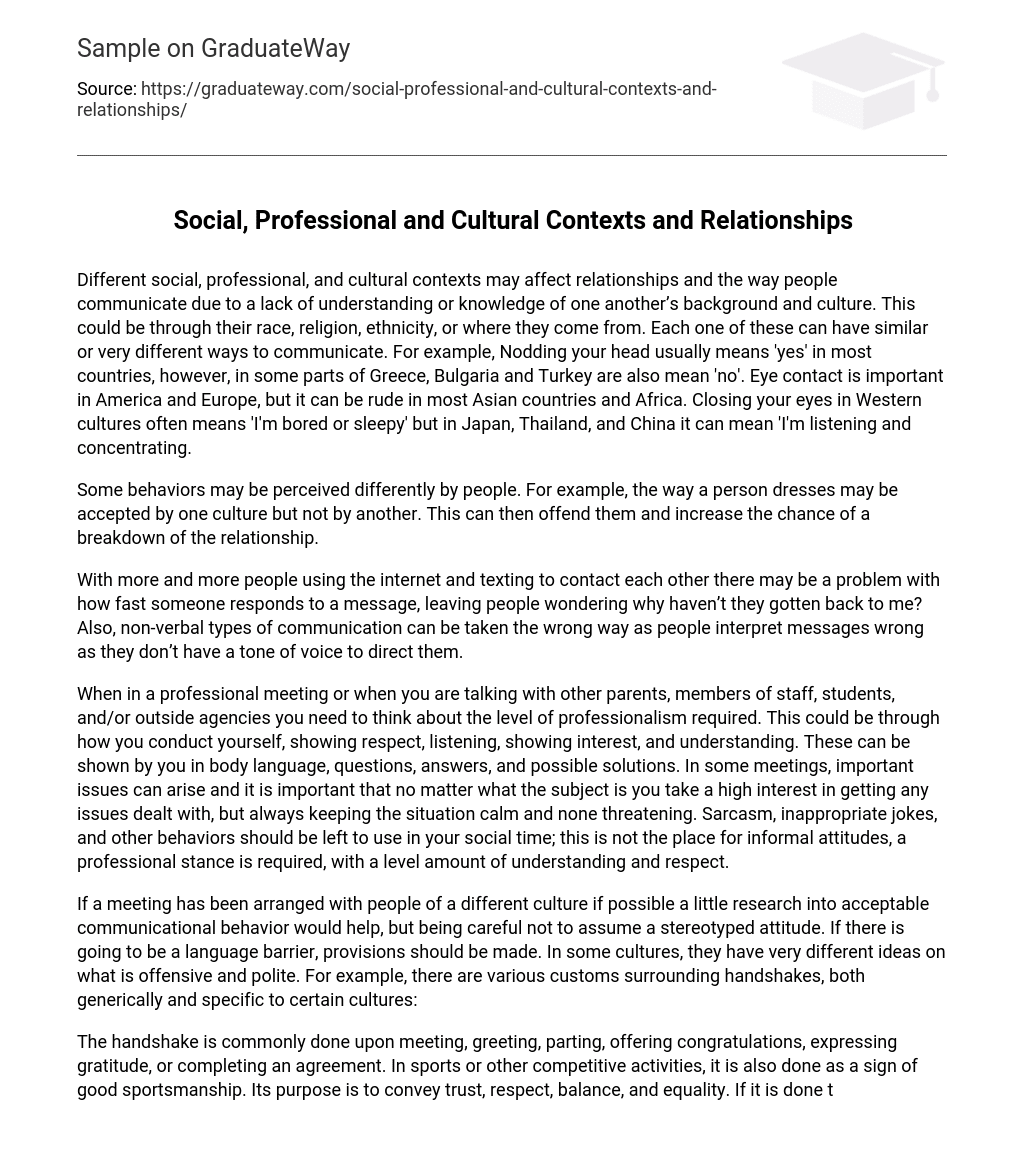Different social, professional, and cultural contexts may affect relationships and the way people communicate due to a lack of understanding or knowledge of one another’s background and culture. This could be through their race, religion, ethnicity, or where they come from. Each one of these can have similar or very different ways to communicate. For example, Nodding your head usually means ‘yes’ in most countries, however, in some parts of Greece, Bulgaria and Turkey are also mean ‘no’. Eye contact is important in America and Europe, but it can be rude in most Asian countries and Africa. Closing your eyes in Western cultures often means ‘I’m bored or sleepy’ but in Japan, Thailand, and China it can mean ‘I’m listening and concentrating.
Some behaviors may be perceived differently by people. For example, the way a person dresses may be accepted by one culture but not by another. This can then offend them and increase the chance of a breakdown of the relationship.
With more and more people using the internet and texting to contact each other there may be a problem with how fast someone responds to a message, leaving people wondering why haven’t they gotten back to me? Also, non-verbal types of communication can be taken the wrong way as people interpret messages wrong as they don’t have a tone of voice to direct them.
When in a professional meeting or when you are talking with other parents, members of staff, students, and/or outside agencies you need to think about the level of professionalism required. This could be through how you conduct yourself, showing respect, listening, showing interest, and understanding. These can be shown by you in body language, questions, answers, and possible solutions. In some meetings, important issues can arise and it is important that no matter what the subject is you take a high interest in getting any issues dealt with, but always keeping the situation calm and none threatening. Sarcasm, inappropriate jokes, and other behaviors should be left to use in your social time; this is not the place for informal attitudes, a professional stance is required, with a level amount of understanding and respect.
If a meeting has been arranged with people of a different culture if possible a little research into acceptable communicational behavior would help, but being careful not to assume a stereotyped attitude. If there is going to be a language barrier, provisions should be made. In some cultures, they have very different ideas on what is offensive and polite. For example, there are various customs surrounding handshakes, both generically and specific to certain cultures:
The handshake is commonly done upon meeting, greeting, parting, offering congratulations, expressing gratitude, or completing an agreement. In sports or other competitive activities, it is also done as a sign of good sportsmanship. Its purpose is to convey trust, respect, balance, and equality. If it is done to form an agreement, the agreement is not official until the hands are parted. Unless health issues or local customs dictate otherwise, usually a handshake is made with bare hands. However, it depends on the situation. Some different cultures see handshaking differently: – In Belgium, handshakes are done often, especially in meetings. In Switzerland, it may be expected to shake the women’s hands first. Austrians shake hands when meeting, often including with children. In Russia, a handshake is rarely performed by the opposite sexes.
Man shaking hands with women can be considered impolite, since hand-kissing is preferred as a ritual for greeting a lady. However, kissing the hand is considered unsuitable for business situations. In some countries such as Turkey or the Arabic-speaking Middle East, handshakes are not as firm as in North America and Europe. Consequently, a grip that is too firm will be considered rude. Moroccans also give one kiss on each cheek (to corresponding genders) together with the handshake. Also, in some countries, a variation exists where instead of kisses, after the handshake the palm is placed unto the heart. In China, where a weak handshake is preferred, people shaking hands will often hold on to each other’s hands for an extended period after the initial handshake. In Japan, it is appropriate to let the Japanese initiate the handshake, and a weak handshake is preferred. In Norway, where a firm handshake is preferred, people will most often shake hands when agreeing on deals, both in private and business relations. In South Korea, a senior person will initiate a handshake, where it is preferred to be weak. It is a sign of respect to grasping the right arm with the left hand when shaking hands. It is also considered rude or disrespectful to have your free hand in your pocket while shaking hands.





